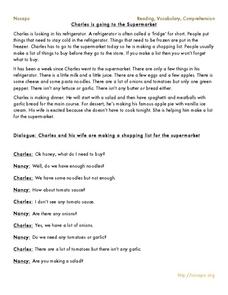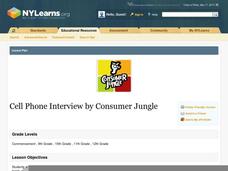Curated OER
Estimating Products
Multiplication on the fly becomes easy with the magic of estimating! Scholars round numbers up to four digits to complete multiplication problems without a calculator. They write in the new factors and the approximate product for the...
Orange County Public Schools
Vocabulary #20 Worksheet – English 1
Five vocabulary activities help kids to put words into context while reinforcing their definitions. They find synonyms and antonyms, finish analogies, and use context clues to study ten words on the list.
Nosapo
Reading, Vocabulary, Comprehension
Whether you teach mainstream elementary classes or older English learners, a set of reading comprehension resources is a great addition to your language arts curriculum. Ten activities each include a reading passage and set of...
Curated OER
Physical Education: Mission Possible
Students participate in a physical education activity, Mission Possible, where they attempt to steal a jug of jewels. They must successfully overcome five challenge areas to complete the activity. Students develop cooperative...
Curated OER
Third Grade Math
In this math worksheet, 3rd graders answer multiple choice questions about estimation, number sentences, money, and more. Students complete 25 questions.
Curated OER
Cell Phone Interview
Are there benefits to comparison shopping? Yes, even with cell phones. It's important to know which carrier is best and why. Learners interview a family member about his choice in cell phone carriers, and compare that person's choice to...
Read Works
Halloween Leftovers
Halloween isn't fun for everyone — but playing together is! Read about Esme and her space pirate friend with a short reading passage, accompanied by ten short answer questions.
EngageNY
Grade 10 ELA Module 4: Unit 2, Lesson 8
Shakespeare's Macbeth has something for everyone. Scholars complete a mid-unit assessment. They craft multi-paragraph essays to analyze how the author's structural choices create tension and suspense in the play's first two acts.
K12 Reader
Two Hens in a Pen
Make a study of -en words with this exercise. Class members first read a short poem that incorporates many -en words. They then respond to three included reading comprehension questions about the passage.
Curated OER
Fact Families
With a few extra numbers, these fact families would be complete! After looking at an example, scholars write in the sums and differences for six equations as part of three different fact families. This is really for beginners to this...
Curated OER
Celebrate Make a Difference Day on October 26, 2013
Join millions of volunteers around the world by uniting for a common mission to improve others' lives.
Curated OER
Whose Point of View? The Journey of Three Generations
A reading of Whale Journey, a fact-filled picture book by Vivian French, launches a study of the life cycle and migration of three generations of gray whales. The interdisciplinary lesson offers opportunities extensions into all subject...
Curated OER
Patterns of 2s, 5s, and 10s
In order to connect the dots in three images youngsters skip count by twos, fives, and 10s. Encourage them to look for patterns as work, and consider giving out hundreds charts for guidance. They can also color these in once finished!
Curated OER
Who are the Co-pilots in My Life?
We could all use some support when making big changes or decisions in life. That's why this instructional activity focuses on identifying co-pilots to support their college dreams. Kids fill out a worksheet. Then they discuss who...
Novelinks
The Tempest: Anticipation Guide
Begin your unit on William Shakespeare's The Tempest with a helpful anticipation guide. Learners read ten statements that connect to the play's literary themes, and note whether they believe the statement is true or false.
Curated OER
Feelin' Buggy
Students discuss five senses, compare and contrast human and insect senses, use adjectives to describe things they touch, smell, and see, and write stories in first person describing what it would be like to be size of insect.
Curated OER
Barbie Bungee
Middle and high schoolers collect and analyze their data. In this statistics lesson, pupils analyze graphs for linear regression as they discuss the relationship of the function to the number of rubber bands and the distance of the...
Curated OER
Musical Activities for Early Childhood Inclusion
Get your movers and shakers grooving to the beat with this series of musical activities designed to meet everyone's needs! Ten games, using an assortment of instruments, bring awareness to one's body, brain, and social interactions in a...
Teacher's Corner
Brandon's Baseball Collection
Ten questions make up a worksheet that challenges baseball enthusiasts to read a graph then answer questions pertaining to the data's range, mean, median, and mode.
Curated OER
Expanded Form
Writing numbers in expanded form is a great way to practice place value, and here scholars do this with numbers up to six digits. There are two examples to demonstrate the process, and scholars complete four distinct sections to keep...
Curated OER
Hopping by 2s
Hop to it! Young counters practice skip counting by two using illustrations of animals hopping from place to place. Each image shows a number sequence and scholars draw in the path as they move from number to number. Encourage them to...
Curated OER
Identifying Patterns
Find the pattern! Eighteen number sequences challenge scholars to identify and complete the pattern, adding at least four digits to the given numbers. All the sequences here involve skip counting by various single-digit numbers,...
Illustrative Mathematics
Cell Phone Plans
Turn your classroom into a local cell phone store. Then, have your cell phone agents use linear equations to visually display three cell plans and their advantages. It makes for a great group project. Discuss how to decide which plan is...
Shodor Education Foundation
Experimental Probability
Spin into a dicey experiment. Pupils use a spinner or a pair of dice to determine the experimental probabilities of each outcome. The interactive allows for either, one, five, or ten consecutive experiments. Using the applet, learners...























